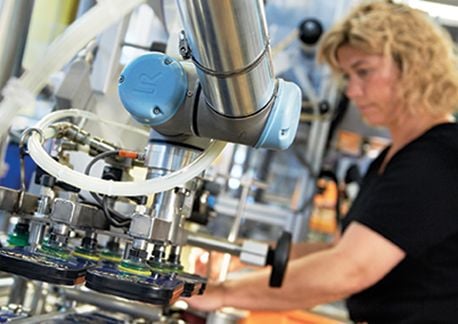This guest blog post was written by Esben Østergaard, Ph.D., chief technology officer at Universal Robots.
When asked how they envision a robot, most people either think of huge, unwieldy robots working in fenced-off areas in large factories, or they think of futuristic cyberbots mimicking human behavior.
But somewhere between these two scenarios lies an emerging reality: a new class of robots, dubbed collaborative robots due to their ability to work directly alongside employees with no safety caging. These kinds of co-bots are poised to bridge the gap between fully manual assembly and fully automated manufacturing lines. Nowhere is that more obvious than in the small and medium businesses sector, that up until now viewed robot automation as too costly and complex to consider.
Unlike their big brothers working behind glass at automobile plants and other big assembly lines, collaborative robots are lightweight and flexible. They can easily be moved and reprogrammed to solve new tasks, meeting the short-run production challenge faced by companies adjusting to ever more advanced processing in smaller batch sizes. The automotive sector still comprises roughly 65 percent of all robot sales in the U.S. However, the Robotic Industries Association quotes observers who believe only 10 percent of companies that could benefit from robots have installed any so far.
Lowering the entry barrier
The reason that number is so low is primarily due to three challenges now addressed by the new collaborative robots: cost, user friendliness, and applicability. Let us start with the financial issue.
Even where workers are affordable, the next generation of complex products will require assembly adaptability, precision, and reliability that is simply beyond the skills of human workers. According to the old rule of thumb, the cost of a robot is equivalent to one worker's two-year salary. But collaborative robots are closer to one fourth of that price. Combine that with the faster turnaround time that robots bring to the workplace, and robotic technology demonstrates that the offshore exodus does not make good business sense any longer.
Instead, the new robots become a high-tech currency that is changing the wage wars into a competition over increasing product quality and quick turnaround.
A plug-and-play robot
With traditional robots, the capital costs for the robots themselves account for only 25 to 30 percent of the total system costs. The remaining costs are associated with robot programming, setup, and dedicated shielded work cells. The "out-of-box experience" with a collaborative robot is typically less than an hour. That is the time it takes to unpack the robot, mount it, and program the first simple task.
This leads us to user friendliness. Instead of requiring skilled programmers, this new class of robots comes with a tablet-size touchscreen user interface, where the user guides the robot arm by indicating movements on the screen. Or, the user can simply grab the robot arm and show it the desired path of movement. The interface is compliant with most industrial sensors and programmable logic controllers. Programming for new tasks is easy-as experienced by Danish manufacturer of hearing aids, Oticon, a company impressed by the intuitive user guidance and the precision of the new co-bots. Oticon needed a flexible robot that would be economically viable for short runs. Rapid advances in medical engineering have resulted in constantly changing production processes and a broader range of hearing-aid models that require a robot to handle smaller batch sizes.
![]()
Hearing-aid manufacturer Oticon uses a UR5 robot arm for different tasks in the foundry, where the suction tool is replaced with a pneumatic gripping tool to handle more complex cast parts. The six-axis robot works in cycles of 4-7 seconds, doing tipping and tilting moves that Oticon's traditional two- and three-axis robots were unable to perform.
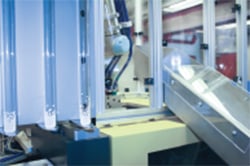
At Oticon, the UR robot is securely fitted to the injection molding machine and can move over the mold and pull up the plastic items. This is done using a specially designed vacuum system that ensures the sensitive items are not damaged.
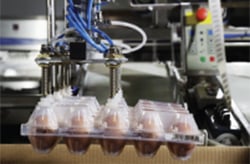
Cascina Italia automated a line packing 15,000 eggs per hour using a UR5 from Universal Robots. Employees can quickly reprogram the robot and are able to work right next to it without safety caging
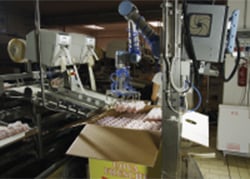
The factory floor at Cascina was not laid out to accommodate separate robot automation, so a portable robot that can quickly be moved between job tasks proved crucial for the Italian egg distributor.
Precision handling
The new robot addresses the issues around applicability and portability not met by the traditional robots that Oticon had employed in the past. The parts for modern hearing aids are getting smaller and are often only a millimeter in size. The hearing-aid manufacturer was looking for a solution that could suction small parts out of a mold. This was impossible manually and not suitable for their "old" two- or three-axis robots that could only move laterally and vertically. If, for instance, a small part is stuck in a mold, the robot has to be able to tip it out.
It took just one day to install the robot for its new task in Oticon's molding shop. Mounted firmly to the injection molding machine, the new robot can position itself over the mold and suction the plastic elements using a specially designed vacuum system. More complex molded components are handled with pneumatic gripping tools. Because of its six axes, the new robot is very maneuverable and can rotate or tilt the parts in order to lift them quickly out of the mold. The robot works in 4-7 second cycles depending on the size of the production run and the component. Due to the optimized production process, the payback period was only 60 days.
Working within space restraints
At Cascina Italia in Italy, a collaborative robot works on a packing line handling 15,000 eggs per hour. The robot is equipped with a pneumatic gripper and fills boxes with egg trays containing 10 eggs each. The job demands precise handling and the careful placement of nine layers of 10 eggs each in a box.
Cascina did not expect to be able to use a robot for the job, but after seeing a demo of the robot at their own factory, it was easy for the egg company to visualize the benefits. Ninety days later, the new robot was operating on the line. Weighing only 11 lb., the robot colleague can easily be moved between packing lines, which is crucial for Cascina employees who handle four different egg sizes and needed a robot that could work next to them within significant space restraints.
Safety first
Safety has been a hot-button issue and the major thrust of research and development in robotics labs for some time. With human collaboration in mind, the new generation of industrial robots has rounded joints, back drivable motors, force sensors, and lighter-weight materials.
If a robot at Cascina touches an employee, the built-in force control limits the forces at contact so the robot does not cause bodily harm, adhering to the current safety requirements on force and torque limitations. In most applications, this safety feature enables the robot to operate with no safety guards after risk assessments have been conducted.
Avoiding back-breaking movements
This is the case at Scandinavian Tobacco Company, where a collaborative robot now works directly alongside employees handling the lids for tobacco tins where tobacco is packed. The new robot spares the employees from having to make back-breaking repeated movements and freed one or two employees who previously performed the tasks by hand. They now carry out other tasks at the factory. There was no room to screen off the robot in the setup at the factory, so employing a collaborative robot simplified the setup and costs considerably.
Scandinavian Tobacco developed their own gripping tool and had one of their technicians do the initial programming. This kept the know-how in the building and ensured high productivity, while avoiding downtime in production and paying for expensive external consultants. The optimized production convinced the owner to keep production in a high-wage Scandinavian country. The return on investment (ROI) for the tobacco company's new robot was 330 days.
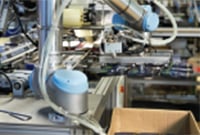
Employees are spared from repetitive back-breaking movements, packing tobacco tins into boxes at Scandinavian Tobacco, now that a UR5 handles this process.
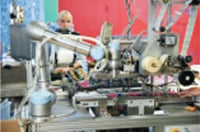
The new robot arm was well received by the employees who have moved on to less strenuous tasks.
From 45 to 70 bottles per minute
At Johnson & Johnson, the employees like working with their new collaborative robot colleague so much they gave it a name. The UR5 is now called "Clio." Larger manufacturers also benefit from the new robots. At Johnson & Johnson's plant in Athens, Greece, a collaborative robot has significantly optimized the packaging process of shampoos and skincare products. The robot arm works around the clock. It picks up three bottles simultaneously from the production line every 2.5 seconds, orients them, and places them in the packing machine. Manual handling processes 45 bottles per minute; robotic-assisted production handles 70 units.
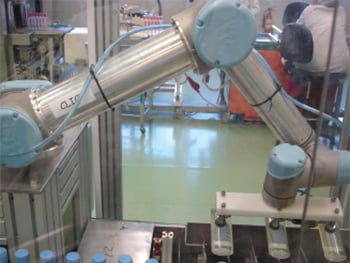 .
.
The bottles are vacuum lifted and transferred cleanly without any danger of scratching or sliding. The dexterity of the robot plays a crucial role, as the label is not printed on the same side on all products and the bottles are various shapes and sizes, which means the robot has to grasp from both the right and the left. Any member of Johnson & Johnson's staff can reprogram the robot for new tasks, saving the company the cost of hiring external programmers.
A new way of approaching robotics
Above are some examples of the new generation of robots solving real-life challenges not previously addressed by robots. When it comes to human collaboration and flexible manufacturing, features of the classic industrial robot must evolve on nearly every level: from fixed installation to relocating, from periodic repeatable tasks to frequent task changes, from intermittent to constant connectivity, from no interaction with humans to frequent collaboration, from space separation to space sharing, from profitability within years to near-immediate ROI. The near future will see even more advances in this nascent field of robotics, changing the way we work and interact with technology.
About the Author Esben Østergaard, Ph.D., is chief technology officer at Universal Robots (UR), and is responsible for the enhancement of existing UR robots and the development of new products. During his tenure from 2001-2005 as researcher and assistant professor in robotics and user interfaces at University of Southern Denmark, he created the foundation for a reinvention of the industrial robot. In 2005, he founded Universal Robots together with two of his research colleagues. They have been granted approximately 30 patents on the technology of the robot. Østergaard also participates in national research projects and is an external examiner at several universities in Denmark.
Esben Østergaard, Ph.D., is chief technology officer at Universal Robots (UR), and is responsible for the enhancement of existing UR robots and the development of new products. During his tenure from 2001-2005 as researcher and assistant professor in robotics and user interfaces at University of Southern Denmark, he created the foundation for a reinvention of the industrial robot. In 2005, he founded Universal Robots together with two of his research colleagues. They have been granted approximately 30 patents on the technology of the robot. Østergaard also participates in national research projects and is an external examiner at several universities in Denmark.
A version of this article was originally published at InTech magazine.


